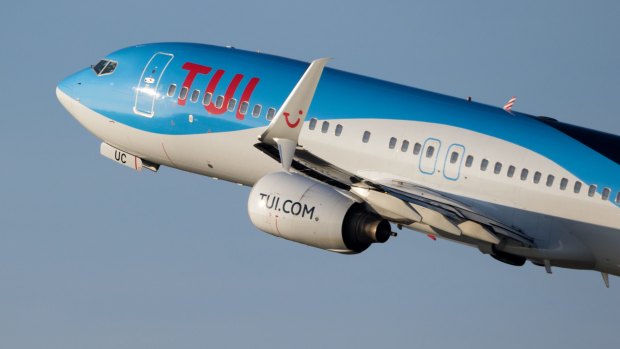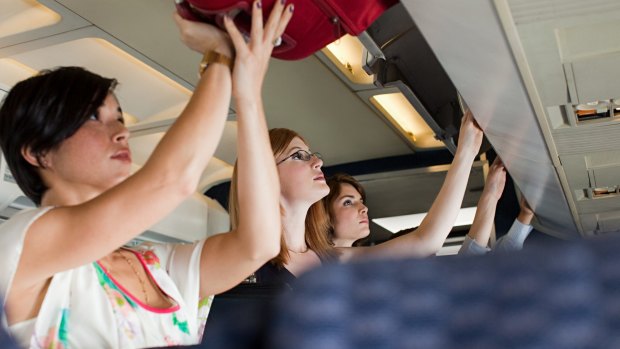This was published 3 years ago
How do airlines calculate passengers' weight? Tui airline's mistake puts spotlight on weighty issue

Airline Tui mistakenly categorised every passenger with the honorific "Miss" as a child and seriously underestimated the plane's weight as a result.Credit: iStock
You're front and centre at your airline's check-in desk, your luggage is on the scales and the weight noted to the nearest one-tenth of a kilogram – but what about you? Because weight matters, and that includes you and your carry-ons. More weight requires more thrust from your aircraft's engines, more speed to get off the ground and more fuel, and the consequences of underestimating your aircraft's weight are potentially serious (not to mention expensive for the airline). Get it wrong, even if there are no safety outcomes, and government regulators charged with the safe operation of airlines are likely to start asking questions.
That's what happened to European holiday airline Tui which copped a serious incident investigation from the UK's Air Accidents Investigation Branch (AAIB) when it underestimated the takeoff weight of an aircraft by almost 1200kgs.
Tui's problem came about as a result of an IT glitch, when 38 adult passengers departing Birmingham for Majorca in July 2020 identified themselves as "Miss" rather than "Ms". That caused the airline's software to classify them as children instead of adults, and to assign each a child's weight rather than an adult's, a difference of more than 30kgs for each of those passengers. As a result, the figures on the load sheet, which the pilot uses to determine the thrust and speed required for takeoff, were out by more than a tonne.

Australian airlines estimate the average weight of a female at 66.7 kgs and a male at 81.8 kgs.Credit: iStock
Despite the stuff-up the Boeing 737 took off safely and the AAIB concluded in its report earlier this month that the "safe operation of the aircraft was not compromised". Tui subsequently amended the software.
Passenger weights can vary
Airlines around the globe calculate passenger weight based on recommendations from airline regulators. Those recommendations vary from one regulator to another. In Europe, the European Aviation Safety Agency has calculated the average weight of a male passenger at 84.6kgs. For females the figure is 66.6kgs and 30.7kgs for children aged 2-12.
There are slight discrepancies, for example passenger weight in summer is a couple of kilos less than in winter. Males travelling in business class weigh more than the average male, female business travellers weigh less, but for the sake of simplicity these are the figures that most European carriers use all year round and for all classes of passengers.
In the USA, the Federal Aviation Administration sets the weight of an adult male at 90.7kgs in summer, 93kgs in winter, but that figure includes carry-ons. For female passengers and their carry-ons, the figures are 81.2kgs in summer, 83.5 in winter. For children aged 2-12, the weight estimate is 37.2kgs in summer, 39.5kgs in winter.
Australia's Civil Aviation Authority (CASA) points out that calculating passengers' weight using the same standard figure irrespective of aircraft size is problematic since it increases the chances of overloading the aircraft, especially small aircraft. Passengers are frequently weighed before boarding smaller commercial aircraft. That's particularly relevant in Australia, where smaller aircraft are often used to ferry passengers around in remote and regional locations.
Based on a survey of almost 23,000 passengers, CASA recommends a sliding scale of passenger weights based on the seating capacity of the aircraft. For an aircraft seating 7-9, the weights are 86 kgs for an adult male, 71kgs for an adult female. For an aircraft with a seating capacity of 150-299 the weights for an adult male and female drop to 81.8 and 66.7kgs respectively.
These are recommendations, not requirements. For example, according to an airline spokesperson, "Qantas uses a CASA approved weight control system to control the weight and distribution of payload on all Qantas operations."
Airlines might make slight adjustments to the weight figures recommended by regulators based on their own weight surveys of passengers.
Several years ago, before boarding a QantasLink flight from Sydney to Port Macquarie, I was asked to step on a set of scales along with my carry-ons. Qantas was checking the figure it was using for passenger weights to see if they needed recalibrating. Air New Zealand is currently going through the same process. According to Air New Zealand Chief Operational Integrity Officer Captain David Morgan, "A customer and crew weight survey is completed every five years to meet regulatory requirements."
What can happen when the crew gets an aircraft's weight wrong?
On March 29, 2009, Emirates flight 407 took off from Melbourne bound for Dubai, but it wasn't exactly textbook. As the Airbus A340-500 approached the end of its takeoff roll and pitched upward for takeoff, the tail struck the ground, and continued to gouge through its aluminium skin until it ran out of runway. Seeing the danger, the captain applied maximum thrust and, after ploughing a furrow across 148 metres of Melbourne Airport turf, the aircraft took off. As it did so it took out a strobe light at the end of the runway and, a little further on, an antenna array, barely clearing the airport fence.
In calculating the required takeoff speed, instead of inputting the aircraft's actual weight of 362.9 tonnes, the first officer hit the adjacent key and entered 262.9 tonnes. That mistake gave a takeoff speed some 40 knots, or about 75 km/h, less than required to get the aircraft off the ground, and what would have been Australia's worst aviation disaster was avoided by a whisker. Both the captain and first officer subsequently resigned.
Can an airline charge passengers by weight?
It can, but there might be blowback. That's what happened in 2013 when Samoa Air started charging passengers at a fixed price per kilogram times the flight distance. More weight means more fuel, the airline figured, so why not make passengers pay by weight? At the time, Samoa Air CEO Chris Langton described charge-by-weight as the way of the future for airlines - but that wasn't the case for Samoa Air. Just two years after the bulk payment began the airline went belly up.
In 2016 Hawaiian Airlines began weighing passengers on flights between Honolulu and Pago Pago in American Samoa – not because it wanted to charge per kilo but because it needed to make sure weight was evenly distributed in the cabin.
Sign up for the Traveller newsletter
The latest travel news, tips and inspiration delivered to your inbox. Sign up now.